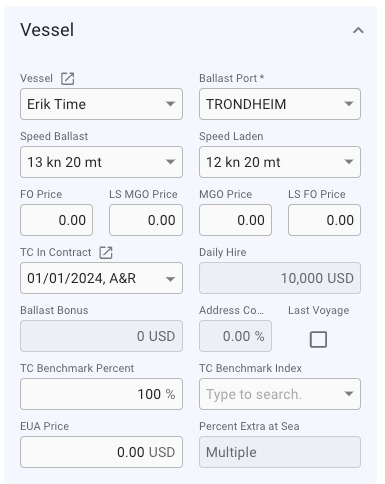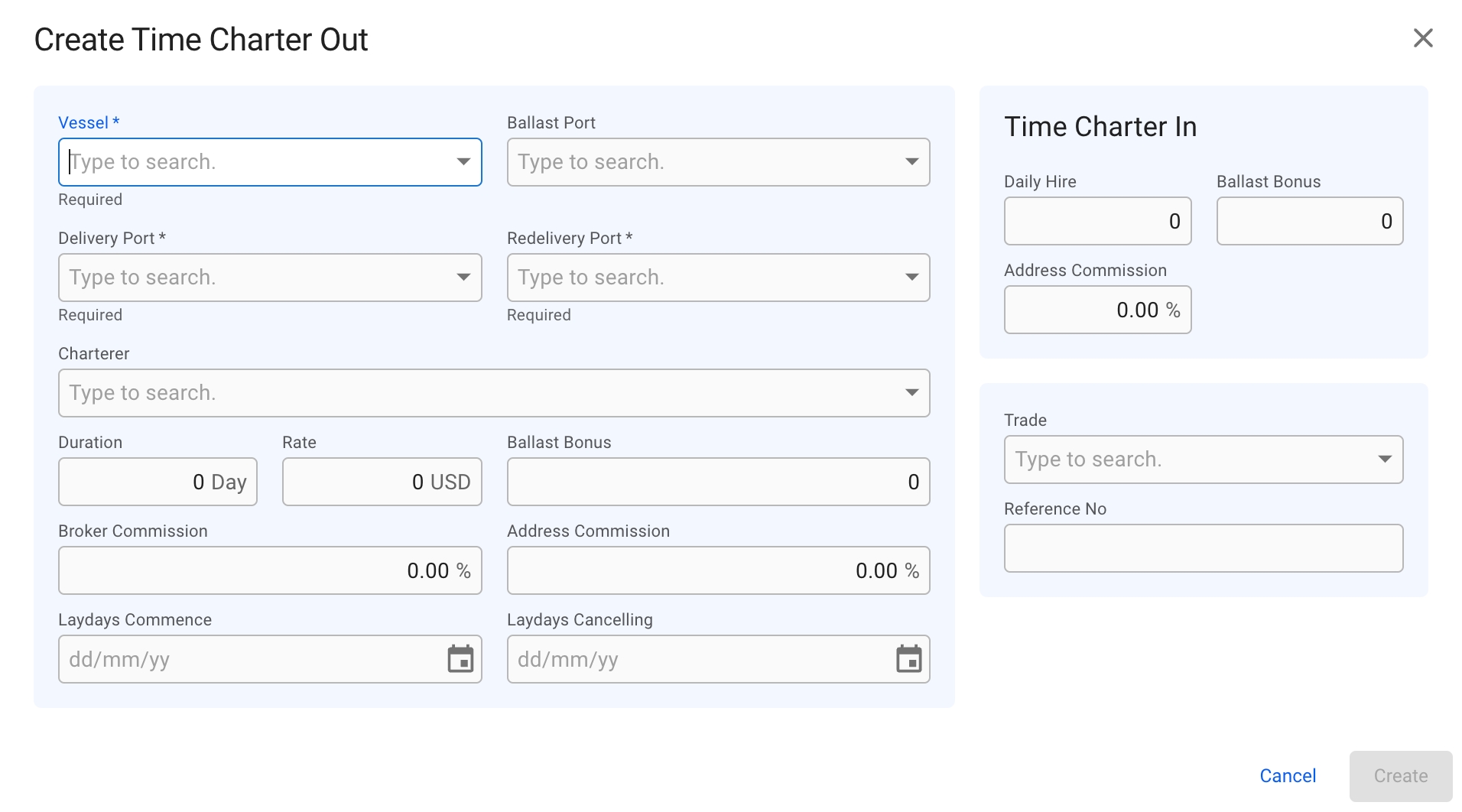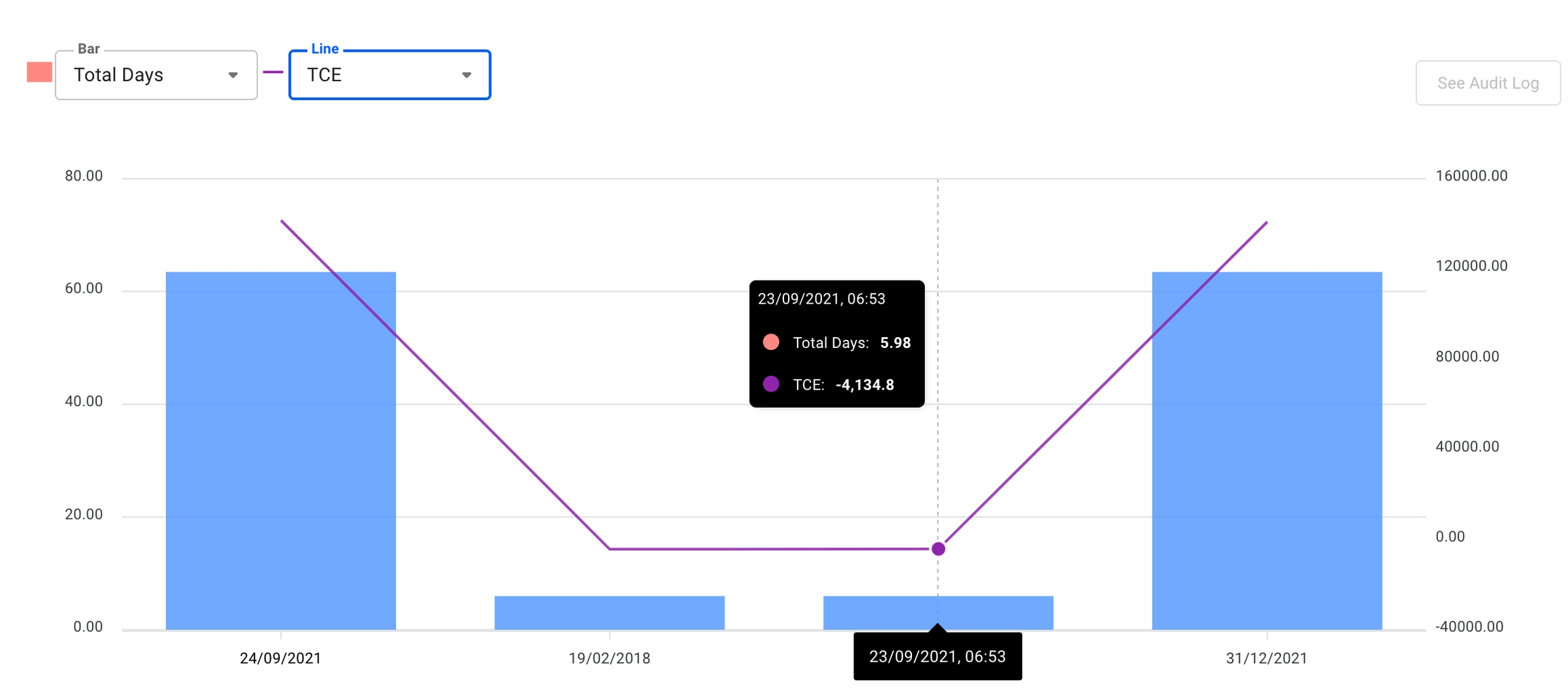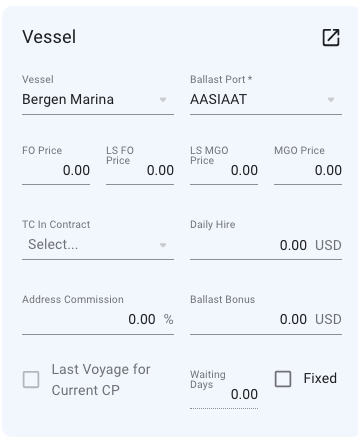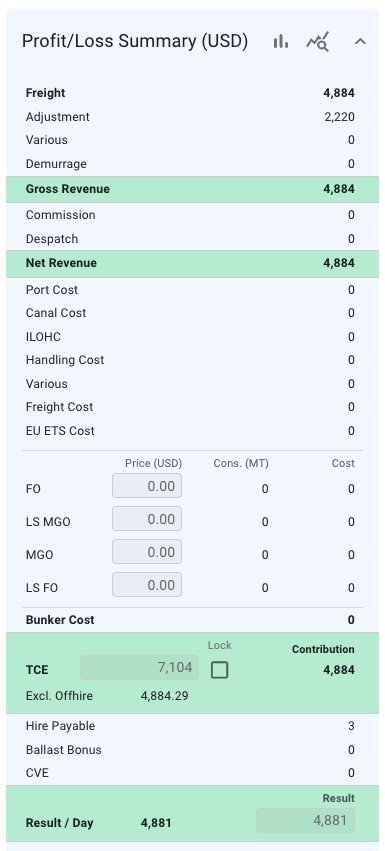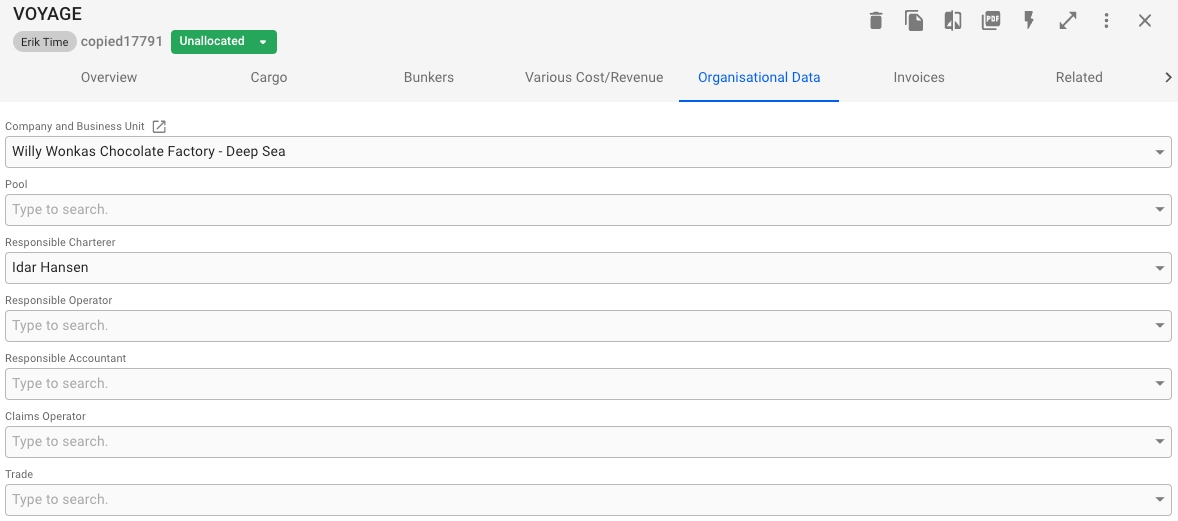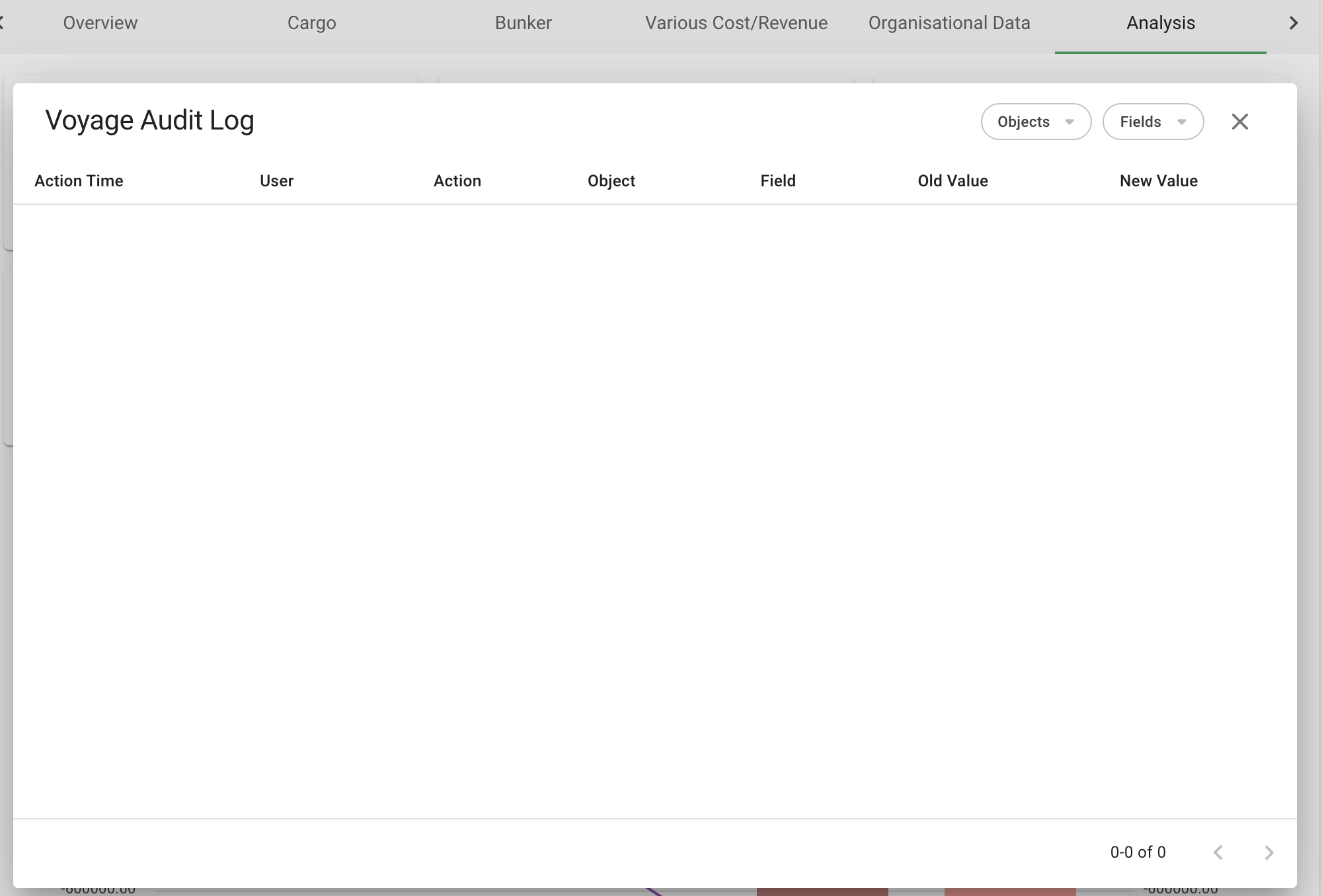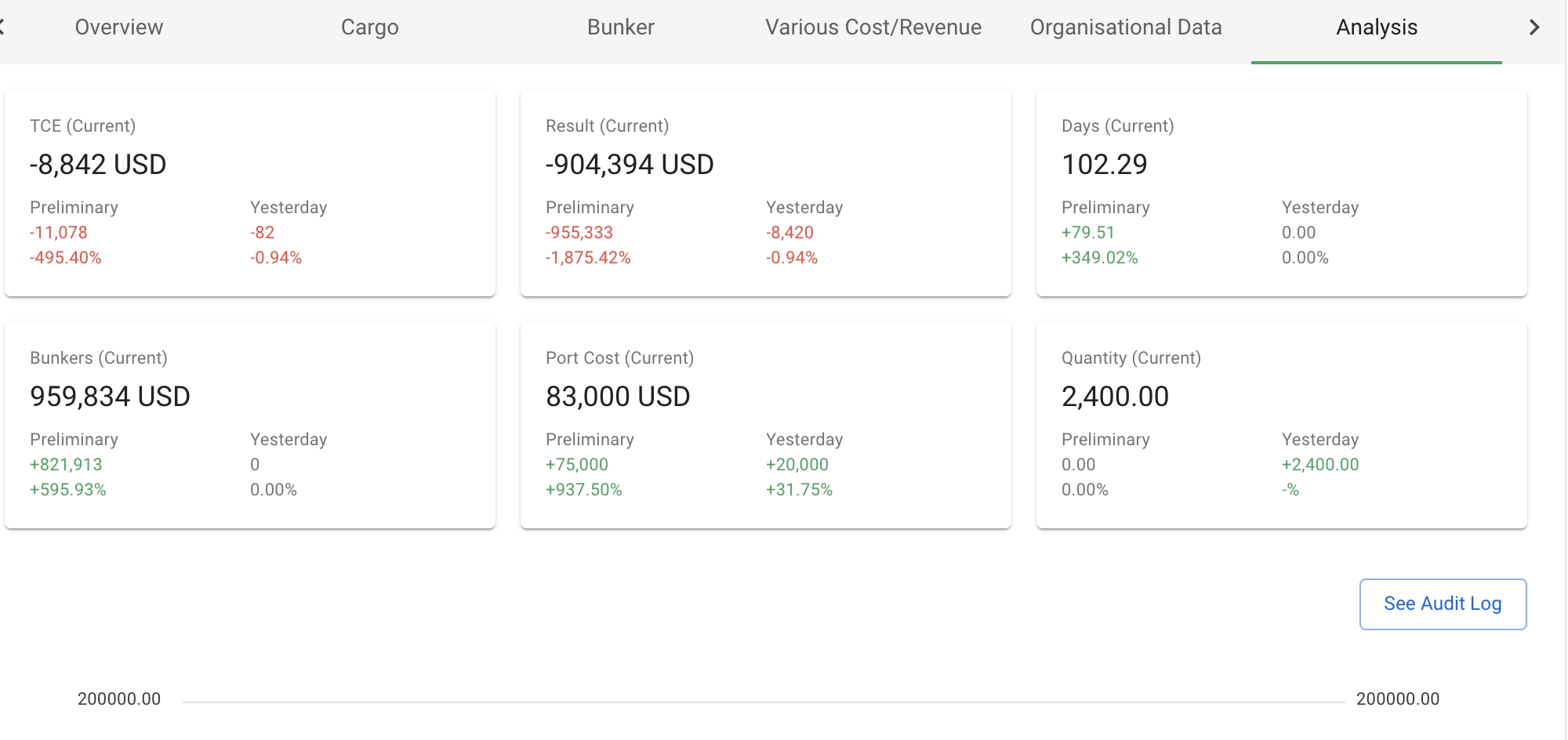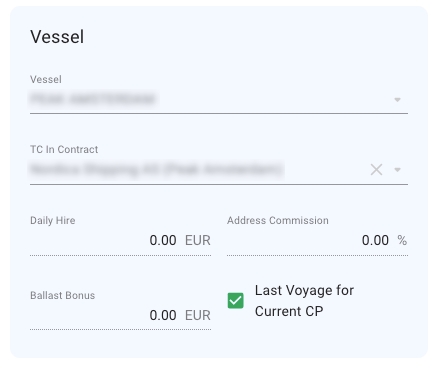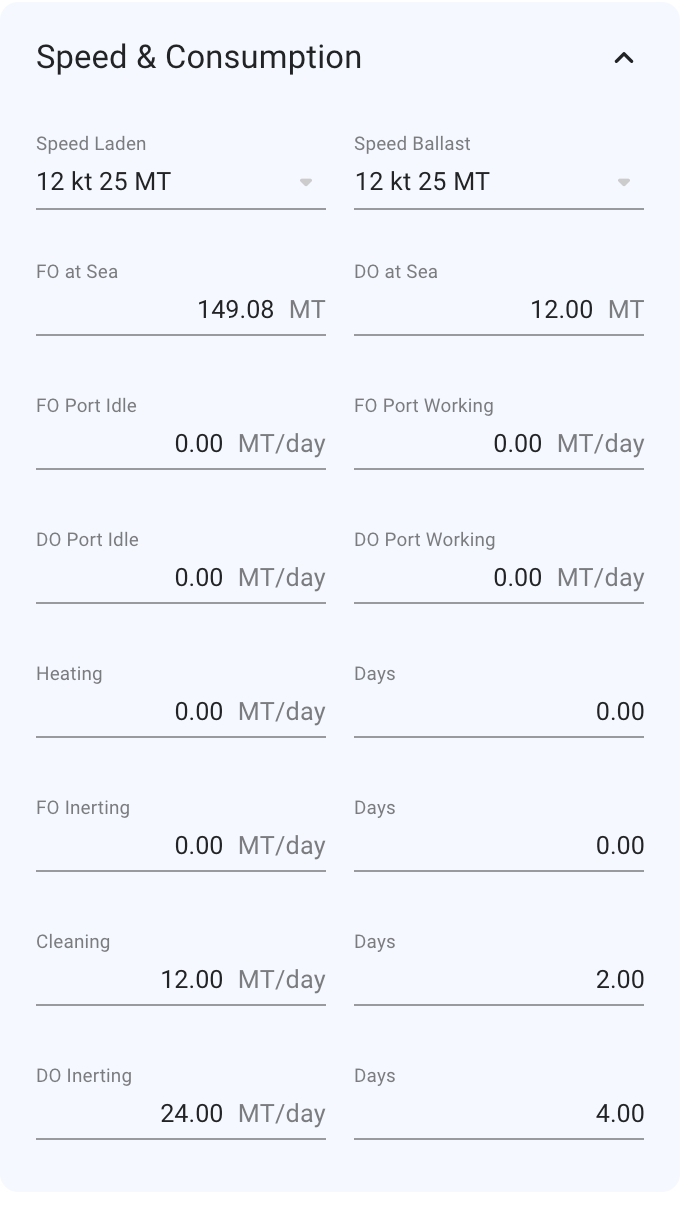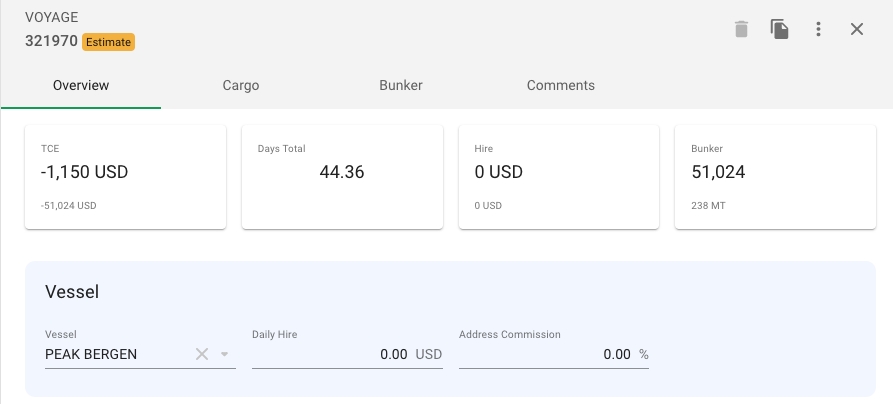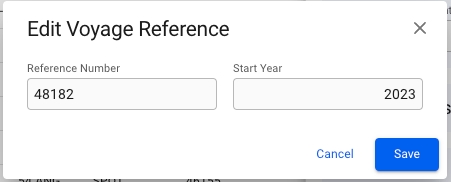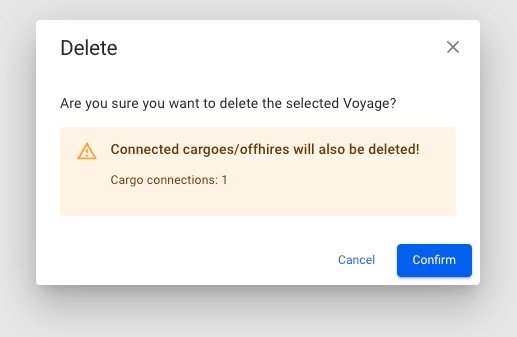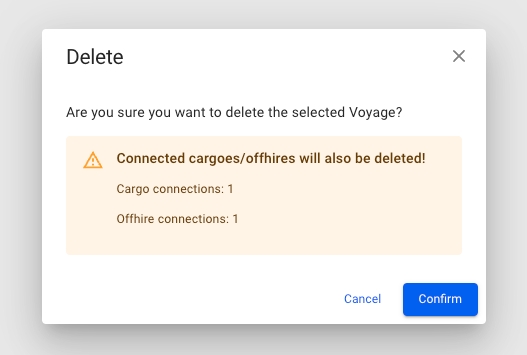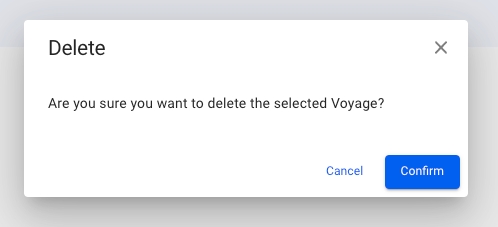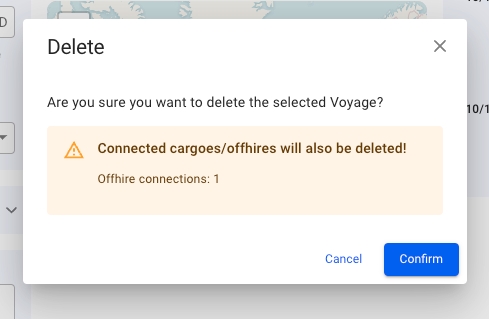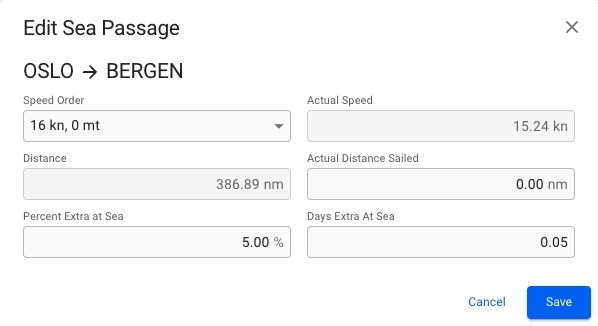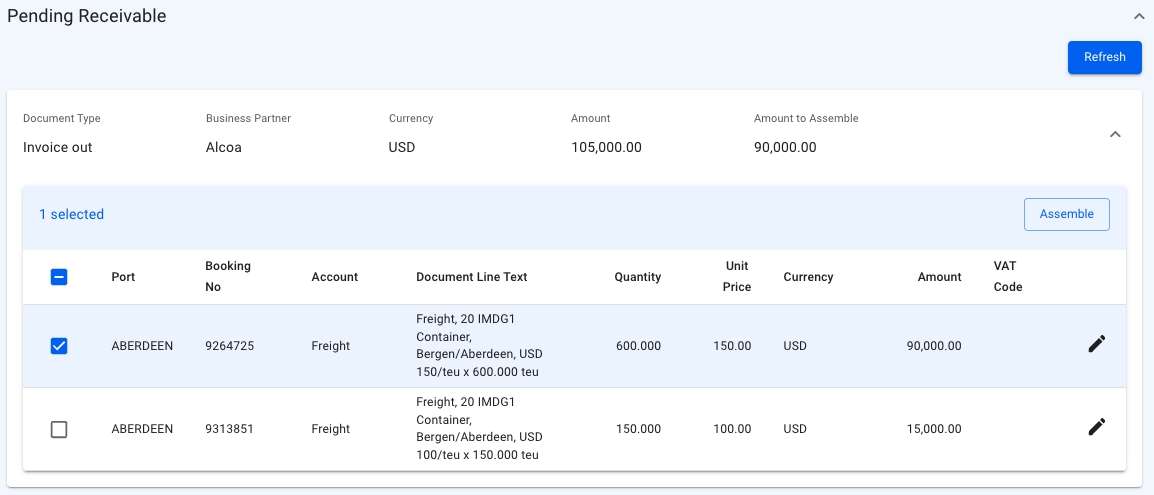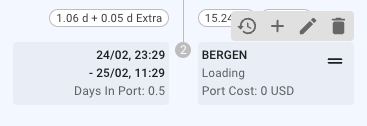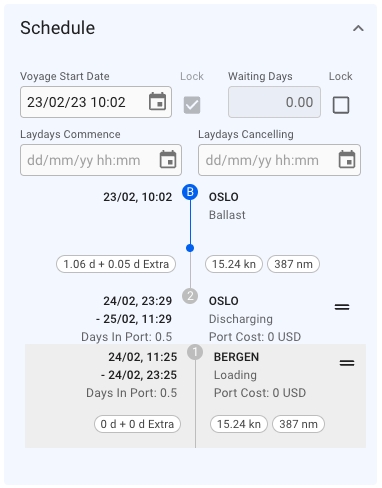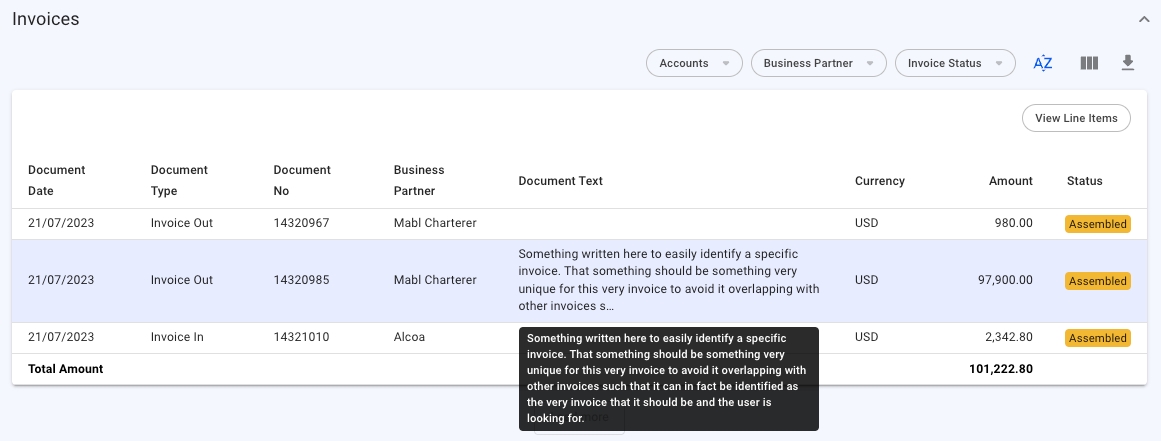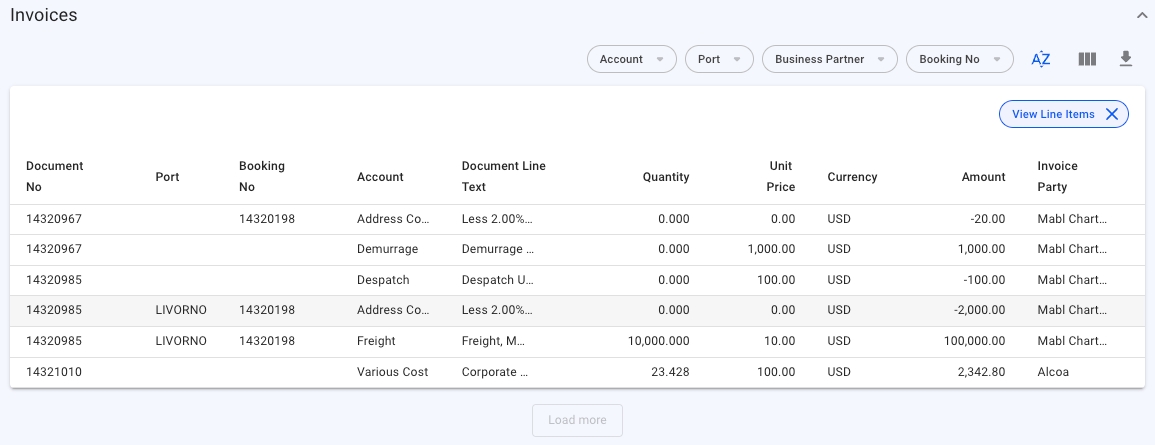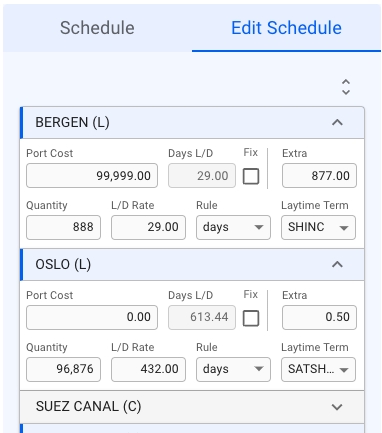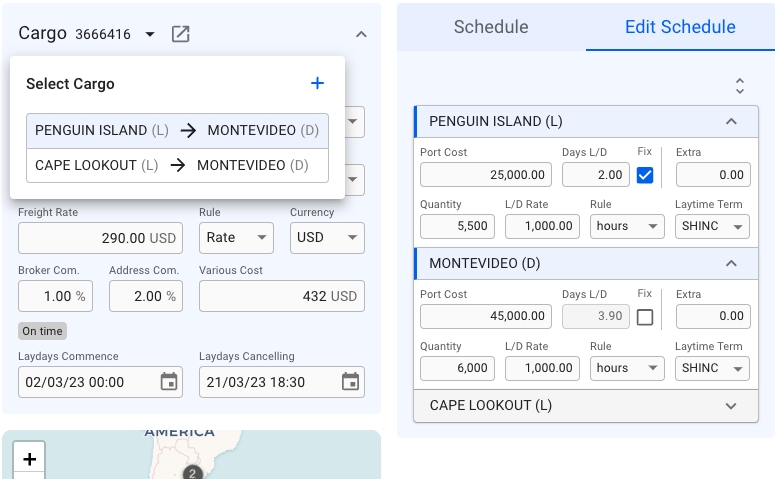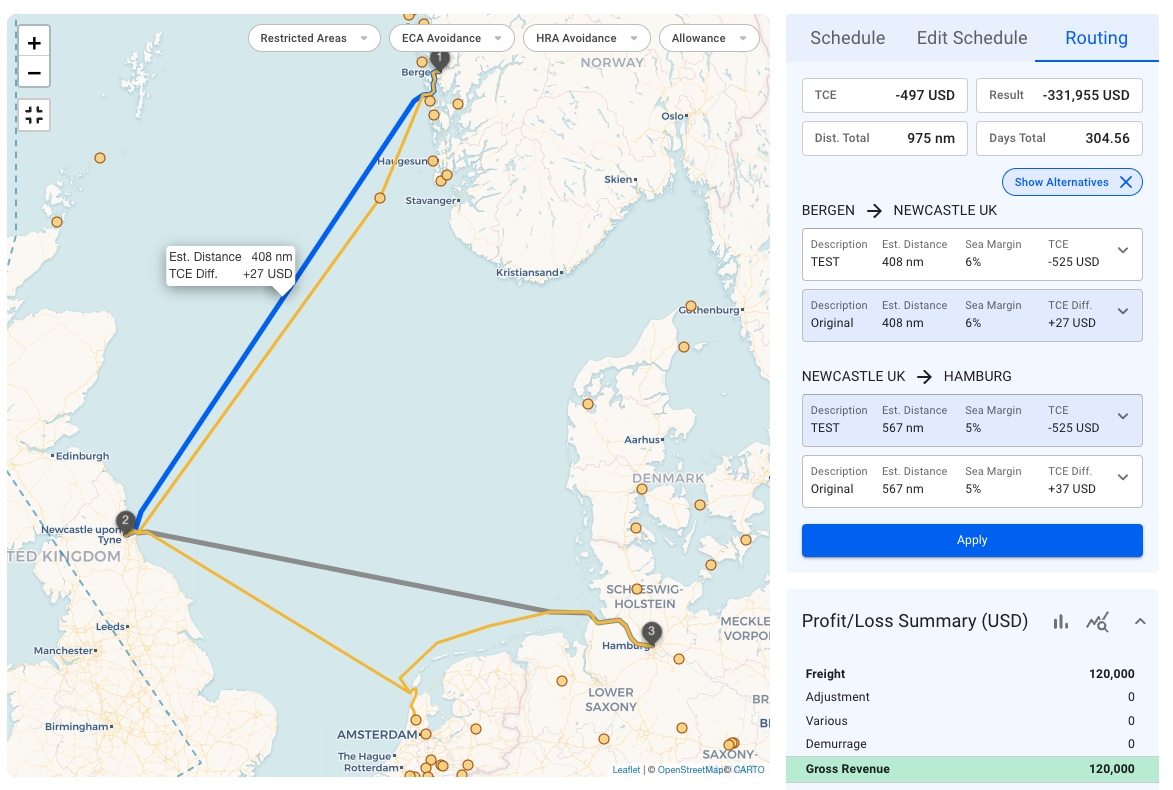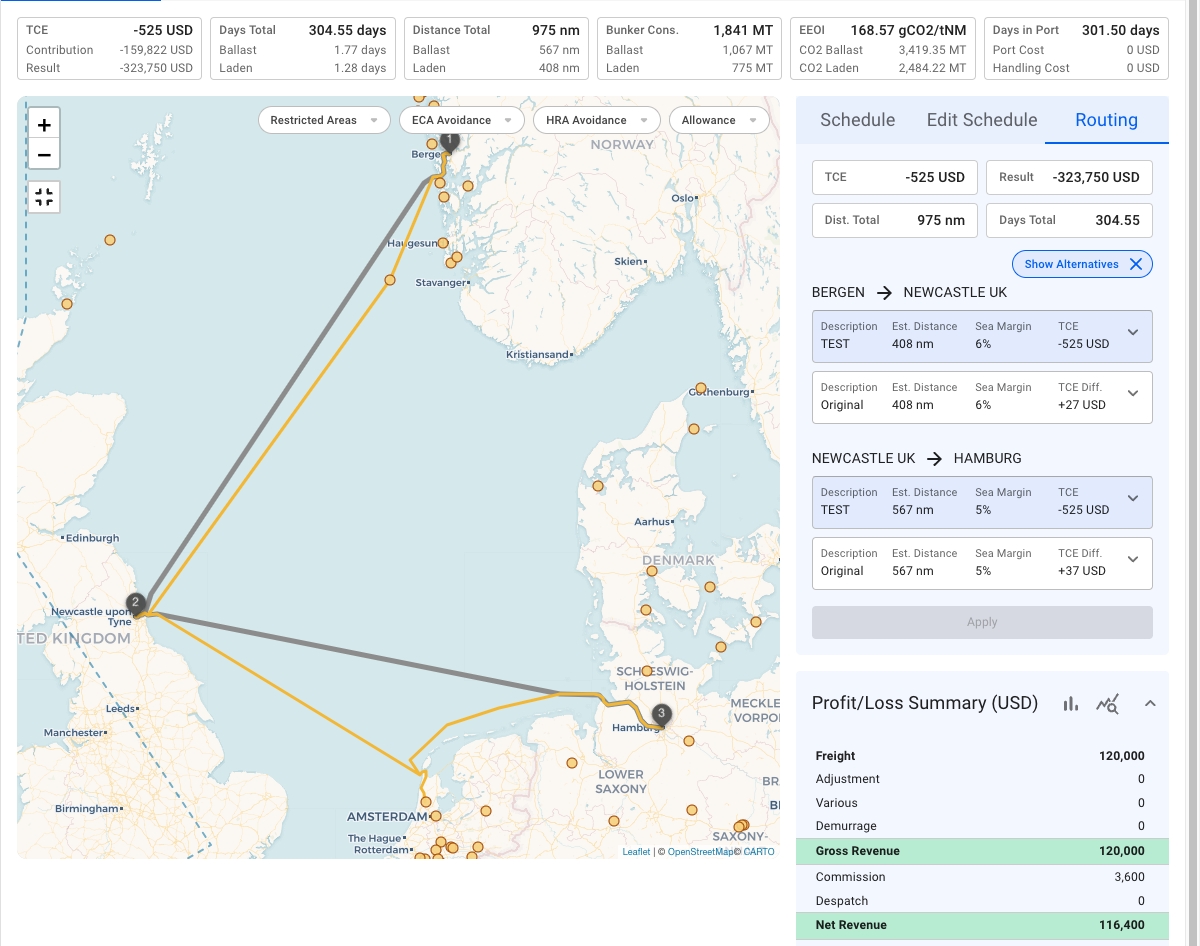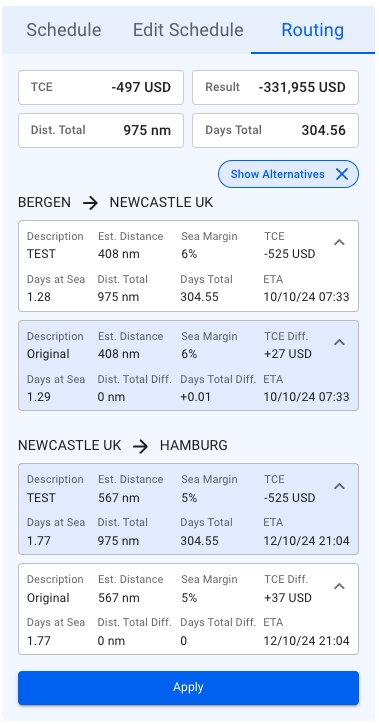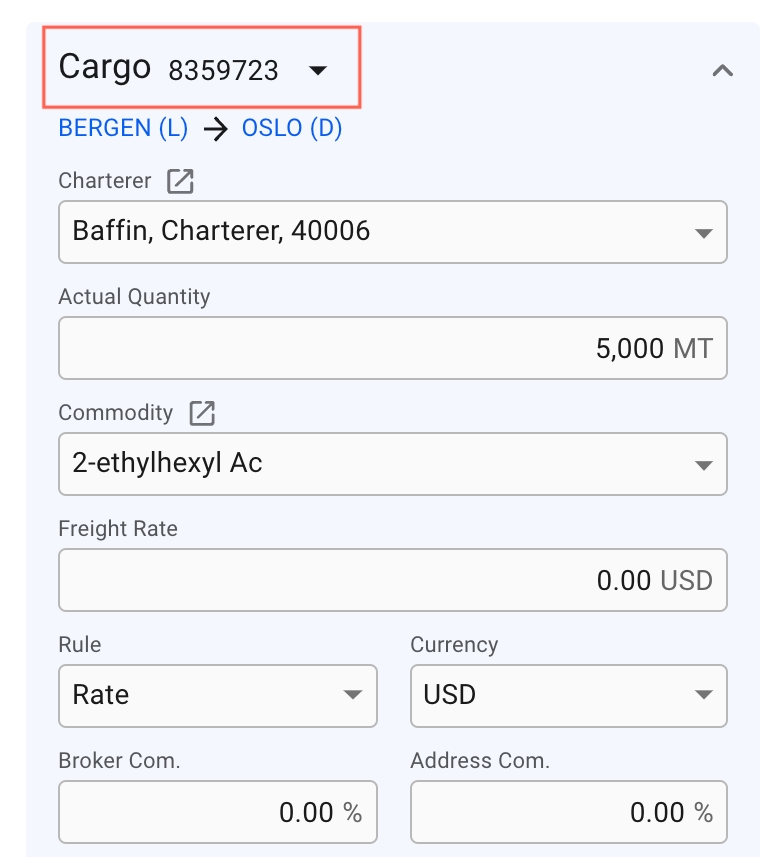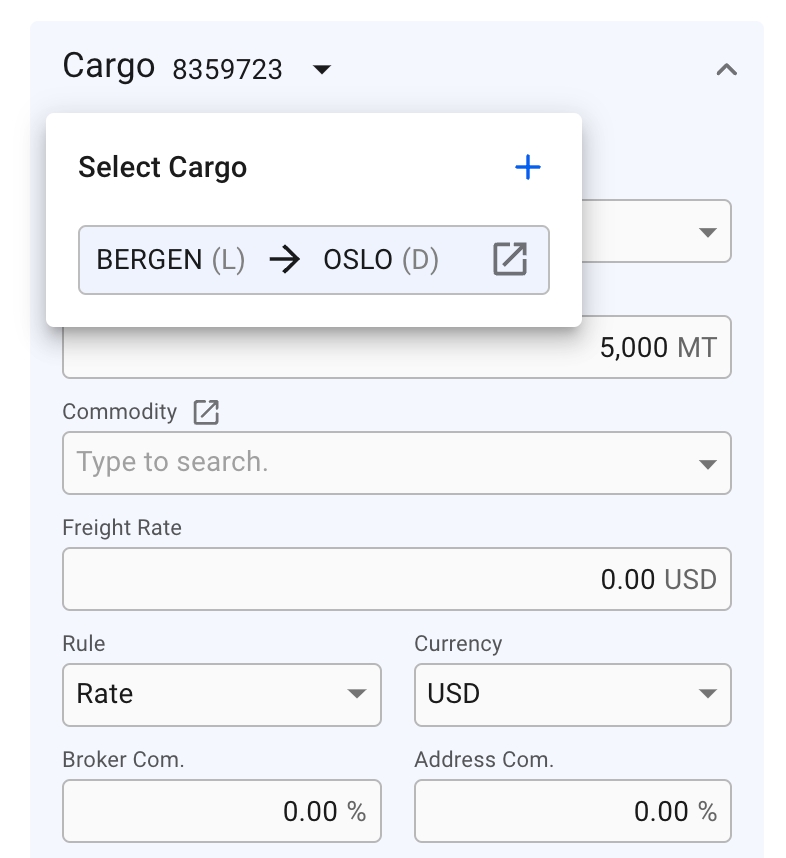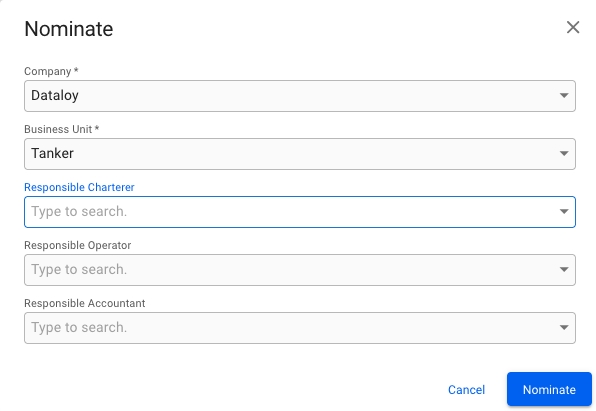
Loading...
Loading...
Loading...
Loading...
Loading...
Loading...
Loading...
Loading...
Loading...
Loading...
Loading...
Loading...
Loading...
Loading...
Loading...
Loading...
Loading...
Loading...
Loading...
Loading...
Loading...
Loading...
Loading...
Loading...
Loading...
Loading...
Loading...
Loading...
Loading...
Loading...
Loading...
Loading...
Loading...
Loading...
Loading...
Loading...
Loading...
Depending on your access permissions the list of voyages might not be visible.
The "Voyages" module can be located from the left side menu.
There are several sorting and filtering options available for you to narrow down what you see in the list view.
From the "Various Cost/Revenue" tab in the voyage drawer, you can view various cost/revenue from the voyage, cargoes on the voyage and Offhires on the voyage.
By default only various cost/revenue from the voyage are shown.
If there are either existing various cost/revenue on the Voyage's Cargoes or Offhires there will appear a filter on the top-right of the list where you can select which other types of various cost/revenue you want to be displayed in the list.
Bunker stocks is a detailed representation of bunkers usage for each voyage. In this list you will find consumption, purchases and sells of bunkers on board for each port call.
The Bunker Stock list can be found in the Voyage drawer under the tab called Bunkers.
Each list starts with the opening balance of the stock. The opening balances displays the balance of the bunker stocks at the beginning of the voyage and are generated based on the previous fixed voyage. When creating voyage estimates the opening balances are generated based on the last fixed voyage on the vessel.
Opening balances can be updated on voyages with status Estimate or Unallocated to be able to do quick calculations. Once a voyage i fixed the opening balance will be recalculated based on the previous fixed voyage and will no longer be editable.
Opening balances are also editable on voyages where the voyage start date is fixed.
To edit an opening balance on voyages where this is enabled,
click on the opening balance row and a modal with the editable values will appear
edit the values
click Confirm to save your changes
It is possible to add additional opening balances for each bunker category on voyages that have the status Estimate or Unallocated and for voyages where the start date of the voyage is fixed.
To add an opening balance:
in bunker stocks list click on the Add Opening Balance button located above the bunker stock list for a given bunker category
enter the values
click Confirm to save the opening balance
Note that the button is only enabled if it is possible to add additional opening balances to the voyage.
The new opening balance will be added after the last existing opening balance in the list.
Open the Voyages module from the menu on the left.
On the top right corner, click the icon.
Select Create Voyage Charterer.
In this modal, you can have two options:
a. you can fill in the required fields and add any additional information about the new voyage
b. you can choose a vessel, and afterwards click the Use CoA Template Cargo button, which will link to the same modal as described here: Create Cargo From CoA Template.
After you have filled in or chosen a CoA Template for the cargo information, you can click Create.
Vessel
Load Ports
Discharge Ports
After choosing a vessel, you will now be able to choose a Ballast Port.
The modal is now draggable, making it easier to see the information "behind" the modal. Hover over the title or the top of the modal to activate it.
There may be several reason for having a voyage without any cargo onboard the vessel. By using the Create Voyage Without Cargo option, you can for instance plan out repositioning of your vessels, or schedule dry docking.
Open the Voyages module from the menu on the left.
On the top right corner, click the icon.
Select Create Voyage Without Cargo.
After you have filled in the required information, you can click Create.
Vessel
Yes
Ballast Port
No
If none is selected the selected Port will be used.
Port
Yes
Reason For Call
Yes
If Dry Dock is selected, an Offhire record will be created.
Port Cost
No
Only available if Reason For Call is set to Bunkering or Extra Port.
Days Extra In Port
No
Only available if Reason For Call is set to Bunkering or Extra Port.
Offhire Start Date
Yes (If enabled)
Only available if Reason For Call is set to Dry Dock.
Voyage Start Date will automatically be locked and set to the selected Offhire Start date.
Offhire End Date
Yes (If enabled)
Only available if Reason For Call is set to Dry Dock.
Must be after Offhire Start Date.
Layout:
The Voyages module contains of a large list of different types of voyages; unallocated, estimate, allocated, nominated, etc. In this list, you can filter the voyages based on several key endpoints to effectively view the required information on your screen. There is a sort icon to the far right, with different options for sorting the list as well. You can read more here: Sorting and Filtering Lists.
Below you can click to read how to create different types of voyages:
By default, the new voyages have Voyage Progress set to "Estimate" and Voyage Status set to "T".
Open the Voyages module from the menu on the left.
On the top right corner, click the icon.
Select Create Time Charter Out.
In the modal, you can fill in the required fields and add any additional information about the new TC voyage.
After you have filled in, you can click Create.
Vessel
Delivery Port
Redelivery Port
After choosing a vessel, you will now be able to choose a Ballast Port.
The modal is now draggable, making it easier to see the information "behind" the modal. Hover over the title or the top of the modal to activate it.
The details of a voyage can be edited in the Voyages module.
When you have located the voyage, click it and the details will show in a drawer or panel on the right hand side. Field values can be edited directly.
Vessel and ballast port can only be changed when the voyage status is "estimate" or "unallocated".
Tiles show the key values like TCE, Days Total, Distance Total, Bunker Consumption, EEOI, Days In Port, of the voyage.
Conditional information:
TCE Excluding Offhire (only shown when there is at least one offhire day)
Offhire days (only shown when there is at least one offhire day)
Voyages on a time charter will have a "TC contract" section, while all other voyages will have a "Performance Cargo" section instead.
Speed Laden: Showing the speed for laden port calls if all port calls have the same speed. If port calls has different speeds this field will be disabled and the text will be: Multiple. Changing this value will update speed for all laden port calls.
Speed Ballast: Showing the speed for ballast port calls if all port calls have the same speed. If port calls has different speeds this field will be disabled and the text will be: Multiple. Changing this value will update speed for all ballast port calls.
Changing vessel in this section will change the voyage's and the connected cargoes' company and business unit to the selected vessel's.
The Cargo section lets you make changes to the most important data on your cargo. Use the Cargo selector button to switch between multiple cargos.
Days Extra In Port: Showing the average days extra in port for load and discharge port. Only enabled when days extra in port is the same for all port calls with the same reason for call. When updating, all port calls with the same reason for call will be updated. Days extra in port can also be updated when editing a port call.
To open the voyage drawer, go to the Voyages module.
The top of the voyage drawer "Overview" tab has four summary cards for TCE, total days, hire costs, and bunker costs.
Note, If the status of the Voyage is closed, it is not possible to make any updates or changes to that particular Voyage.
Click expandto open detailed charts for the numbers in the summary.
The "result" chart is a waterfall chart for costs and revenue on the voyage. Hover the mouse over the bars to see further details behind the calculation.
The "days" chart has a timeline chart for the port calls on the voyage and a table of the total days on the voyage.
The port calls timeline shows the days at sea and days in port. It also shows the names of the ports above the bars. Hover the mouse over each bar to see more information.
Here you may add organisational data to your voyage.
Note, The Company and Business Unit fields depend on each other. If one of the details is set, you may see linked items that correlate to the former attribute when selecting the second field. Moreover, if you proceed with an element not linked to the former attribute, the first field will be cleared.
* For example, there is Company A, which has a link to Business Unit A. When creating Voyage's organisational data, after selecting Company A and expanding the Business Unit, you will get a list of options. The list will contain all the Business Units, but Business Unit A will be marked as linked to the selected Company. Next, if linked Business Unit A is chosen, you will end up with Company A and Business unit A. Otherwise, if the selected Business Unit is not linked to the preferred Company, the Company field will get cleared, and you may observe a list of Companies related to the selected Business Unit.
Only applicable for voyage statuses "Estimate", "Scheduled Unallocated" and "Scheduled Allocated".
Bunker prices can be changed from the Overview/Bunker tabs.
Click a row to edit bunker price
Edit the price for each bunker type in the modal
When in a voyage drawer the analysis tab is available in the tab section. In this tab you will be presented with a graph to give you a visual view of the development of key values in the selected voyage.
The graph that is displayed represents the total days for the columns, and the TCE for the line. These values can be changed in the dropdown fields on the top left. The timeline shown will be from the preliminary snapshot is taken to the current date. If the voyage is closed, the last value will be the last time the voyage was changed instead of todays date.
To efficiently create a voyage, and link them with CoAs, you can create voyage based on a CoA Template Voyages. The CoA Templates Voyage are the template voyages that are maintained in the Budgets module.
Open the Voyages module from the menu on the left.
In the top right corner, click Create .
Select Create Voyage From Template.
In the modal, select a CoA template voyage to create the new voyage. The fields that are pre-filled are the ones that were filled in when creating the CoA template itself, which the new voyage will inherit.
Click Create.
The modal is now draggable, making it easier to see the information "behind" the modal. Hover over the title or the top of the modal to activate it.
Looks and works quite similar to Create Cargo From CoA Template.
The summary section displays all cost/revenue items, including fuel consumption and price, related to either cargo, voyage, or port call. This breakdown displays different figures for Voyage Charter and Time Charter estimates.
When the voyage drawer is open, selecting Open Full Screenexpands the panel and shows an additional section/panel summarising the profit/loss for this voyage.
To show the analysis section, click Analysisat the top of the panel. To show an overview bar chart, click Result Chartat the top of the panel.
The "Schedule" section in the Voyage drawer shows a timeline of port calls on a voyage. You can create, rearrange, delete and edit port calls directly from this screen.
When hovering the mouse over a port call in the schedule, a toolbar in the upper right will appear.
To insert a port call before or after the port call you are editing, click the Create Newbutton and select Before or After. A window to create a new port call then opens.
To edit a port call, click the Editbutton.
To delete a port call, click the Deletebutton.
To change the order of port calls, click and drag the Movebutton to move the port call into place.
In the voyage drawer at the schedule section you will find a checkbox for locking the update of voyage start date and ballast port. This checkbox is not visible while the voyage has status Estimate or Unallocated.
When you are in the analysis tab and you select a snapshot from the analysis chart the See Audit Log will be activated, and you may click this button to see the audit logs from the previous snapshot to the selected snapshot. This button is not activated for the first (Preliminary snapshot) as this has no previous snapshot to compare with.
The audit log in the analysis section will show audit logs between the selected Snapshot and the previous snapshot.
From the voyage drawer it is possible to change the status of the voyage by using the status chip next to the reference no at the top of the drawer.
From Estimate to Allocate:
When changing status from estimate to Allocate, the following modal will show, where you have to select the vessel, and if you want, you can manually change the position. It will by default be put last.
From Estimate to Nominated:
When changing status from Estimate to Nominated, the following modal will show. If it is a TC voyage with missing laycan on the TC, you will have to fill in the layCan as well.
Information about the tab "Organisational data"
In the Organisational data tab in the voyage drawer you can edit the following information:
Company and Business Unit
Pool
Responsible Charterer
Responsible Operator
Responsible Accountant
Claims Operator
Trade
To edit any field in the tab, click into the field and start typing. Then select the desired option. Field will automatically save when you click outside or use tab key to exit the field.
Company and Business Unit field is mandatory if the voyage status is NOT Estimate or Unallocated. When editing company and/or business unit, you will get a warning that alerts the user that the connected cargoes will also have their companies and business units changed.
When clicking the OK button, the company and/or business unit will be changed for the voyage and all the connected cargoes.
Only applicable when the voyage does not have TCin
In order to get a complete voyage result estimation, it is possible to edit the daily hire and address commission for vessels/voyages that does not have TC-in present in the system.
In the voyage drawer at the vessel section you will find a checkbox for setting "Last Voyage for Current CP". This checkbox is disabled when there is no TC In Contract registered.
From the "Related" tab in the voyage drawer, you can view, add and edit laytime calculations. Expand the collapsible section titled Laytime Calculation and click the Create button to add a laytime calculation for the opened voyage.
In the Speed and Consumption section in the voyage drawer you can update the various fields for consumption for a voyage. This section can be found in the Overview-tab in the voyage drawer.
In order to expand the section to see and edit the fields, click expandon the far right of the top right summary cards.
Once the expand icon is clicked the fields will be displayed like this example:
Note that if the field for Speed Laden or Speed Ballast is changed in the vessel section it will also affect the corresponding field in this section as well, and vice versa.
For estimates it is possible to set the TCE or Voyage Result and let the system calculate the freight rate. To make the system calculate the TCE and Voyage Result again, uncheck Lock.
From the voyage drawer actions it is possible to change the Voyage Reference Number or Voyage Number, depending on the voyage status.
When voyage status is Estimate, Unallocated or Allocated, it is possible to change the Voyage Reference Number.
When voyage status is Nominated, Operational, Operationally Closed, Invoiced or Closed, it is possible to change the Voyage Number.
Clicking Edit Voyage Reference... or Edit Voyage Number... in the options meny opens a dialog box where the current values can be modified. In addition, the dialog box contains a field for changing the Voyage Start Year.
Only voyages of status "Estimate" and "Unallocated" can be deleted. Otherwise you must change the status before you can delete.
Find a voyage (i.e through the Voyages page).
Click to open the voyage you want to delete.
At the upper right corner of the panel, click Delete.
Click Confirm to delete the voyage.
Voyages can be connected to Cargoes and/or Offhires, as well as scheduled voyages if the voyage is a template.
When attempting to delete a template voyage that has scheduled voyages either at the Nominated or later stages, an error message will show instead.
The delete-voyage modal will look differently depending on whether it has connected entities:
No connections:
Only Offhire connection:
Only Cargo connection:
Offhires and Cargoes:
The voyage map shows the voyage schedule, including alternative routing pointsthat can be added to the schedule between port calls. More routing points will be revealed as you zoom in on the map.
Click on a routing pointto show information about the point in a popup, including name, position, and GMT offset. When a routing point is clicked it will also be possible to add the routing point to the voyage route. When clicking 'Add to route', a pop-up will appear where you have to choose between which port calls the routing point shall be added.
Routing points that are on the voyage can be removed. When clicked, a button will become available 'Remove from voyage route'. When this is clicked, a confirmation box will appear. When confirmed, the routing point will be removed from the voyage.
The interactive Voyage Map features several restricted areas:
Emission Control Areas
Open Loop Restricted Areas
Restricted Areas are visible on the map and depicted by Blue or Red dashed lines (See Figure 1).
The leftmost dropdown filter allows changing the settings to include the particular group of Restricted Areas in the map or not.
From the "Related" tab in the voyage drawer, you can view, add and edit days. Expand the collapsible section titled Offhire and click the Create button to add offhire for the opened voyage.
A section in a Voyage drawer that visualizes the schedule and port-call-related information.
The Voyage schedule visualization may be found on the right-hand side of a voyage drawer.
This section is highly customizable: e.g., you may change the voyage start date, lock it, edit the Voyage's speed, update the port call sequence, and much more!
The Schedule Timeline is a fully interactive module. Each port represents a draggable block - if you reorder the blocks, you will update the port call sequence on the opened voyage correspondingly:
The small ovals inside of each Port Call block includes a piece of related information: Days at Sea + Extra Days at Sea, Actual Speed, and Distance between Ports. Every oval is clickable and allows editing corresponding sea passages.
Moreover, the Port Call blocks include a small functional bar that provides the following actions on the voyage schedule sequence: show Port Cost history overview, create new Port Call to the current schedule, edit the selected Port Call, or delete the Port Call.
This tab shows a list of the cargoes connected to the voyage
By clicking the icon you can edit the columns shown in the list, rearrange the columns and even enable showing of some columns that are unchecked by default.
In the "Invoices" tab in the voyage drawer, you can quickly see and manage the Pending Receivable/Payable document lines, as well as the Invoices connected to the voyage. The tab is only visible to voyages that do not have status "Estimate".
The sections show you a list of all document lines that have not yet been assembled. Clicking on any of them allows you to edit certain parameters. Selecting one or more document lines will allow you to assemble them.
The invoice-section shows a list of all assembled invoices connected to the voyage. There er multiple filters to allow you to quickly and efficiently find the invoice you are looking for. Clicking on an invoice will open a document drawer, showing more details.
At the top right of the section below the filters you can click a button that says 'View Line Items' which will swap out the documents in the list with the document lines of the documents on the voyage. This list has document line-specific columns, however clicking one of the document lines will open it's corresponding *Document* drawer.
In addition to separate columns, this document line list also has adjustments to its filters at the top of the section as well. The document line list has filters for Account, Port, Business Partner(Invoice Party) and Booking Number as shown in the picture above.
Voyage drawer
The Voyage Edit Schedule segment may be found on the right-hand side of the Overview tab in a Voyage Drawer.
The edit schedule tab includes a complete list of for all the Voyage's cargo.
There are three core elements involved: Selected Port Calls, Selected Cargo, and the rest.
Selected Port Calls: these objects are highlighted by the blue background and a small blue line on the left of the Port Call port (see figure 2). The selected port calls display data for the respective selected Cargo.
Selected Cargo: the currently selected cargo can be chosen inside the select cargo modal, which can be invoked by clicking the expand cargo button (triangle facing down inside the left section, see figure 3). The selected cargo will be the subject of the Edit Schedule list. The Port Calls contained in the list correspond to the selected cargo, and the related values change dynamically if another cargo is chosen.
The rest: the rest can be considered all the grey options inside the list. These options are also expandable and can be edited, but they don't belong to the selected cargo and, thus, are not the focused elements (e.g., SUEZ CANAL Port call in Figure 2).
Each list item is interactive and can be collapsed or expanded. When the selected cargo is changed, the corresponding cargo ports expand and get visually highlighted, the corresponding values are updated.
Moreover, the collapse button can expand Port Calls related to the selected Cargo, Expand all Port Calls, or Collapse all. The button may be found on the right over the first PortCall (see figure 3).
Next to the Port Call port name, there is a Reason For Call specified inside of parentheses - L means Loading, D - discharging, and C - canal passage.
A TC Voyage will not have a Cargo Section on the Overview Tab like normal Voyages, but instead have a Time Charter Contract Section displaying the Time Charter Contract. In this section you can edit the most important fields on a Time Charter directly through the Voyage Drawer or click the -icon to Open the Time Charter Contract Drawer
Both Duration and Rate fields will be disabled if there exists more than one Duration on the Tc contract, or a Duration has multiple Rates.
The Calculate Profit/Loss checkbox is only available while the Voyage still has status Estimate, and will toggle calculation of profit/loss based on bunkers.
A functionality to compare voyages' values to each other to get the best overview.
The comparison button can be found as a primary action in the Voyage drawer:
In this view, you are able to have an overview of the voyages to compare, copy the voyages you want to compare and/or open the Voyage drawer of the voyages:
In this first implementation, you are able to compare the Profit/Loss values, such as Freight, Total Port Cost, Bunker Cost, Various Cost, Contribution, TCE and Result between the voyages. The voyage you are comparing to is the left-most voyage. When you use the copy-function to the right of the table header, you copy that specific voyage. Meaning, the values will initially be the same, until you alter the values yourself. That is why voyage #1 and voyage #3 are identical, only voyage #2 was altered here. If you want to copy voyage #2, a new voyage #4 will have identical values to voyage #2, etc.
By clicking the reference number of the voyage (blue numbers) to the left of the table header, you will open the Voyage drawer of that specific voyage. There, you can view and/or alter the voyage, as the table rows are uneditable as of now.
A section in a Voyage drawer found in the third tab of the Schedule module
The 'Routing' tab allows comparing different routes regarding essential information such as Voyage TCE, Voyage Result, total distance, total days, etc.
See the screenshot below (Image 1) for an example:
A voyage going from Bergen to Hamburg through Newcastle is displayed. The routing tab illustrates an alternative route for each leg on the mentioned voyage. As presented in the screenshot, there is a key difference between the routes:
TCE Difference: the TCE difference indicator shows the difference between the alternative route TCE and the currently selected route TCE. So, for the leg, Bergen -> Newcastle, the current TCE is -525 USD. On the other hand, selecting the alternative route will result in +27 USD, which is -497 USD of TCE total (See Image 2).
Estimated Distance: illustrates the estimated distance for each leg, original and alternative.
Sea Margin: shows the sea margin.
The map is also interactive and helps to visualize the alternative route, providing crucial data.
It is also possible to compare the routes in more detail! For instance, take a look at the screenshot below:
Clicking the top-right arrow in each container expands the detailed information.
The apply button proceeds with the changes and saves the selected route for the current voyage.
Note: The alternative routes may be created manually or must be coming from a third party, such as weather-based routes, etc.
With the Sensitivity Analysis tool you can run calculations on a chosen parameter to evaluate risk.
Click on a voyage in the list or board to open it in the drawer.
At the top right, click on Functions.
Select Voyage Sensitivity Analysis.
Select a voyage parameter which is then adjusted by the numerical variance for each calculation.
The chart shows all the calculated values for the voyage. There are 15 data points, with the current voyage displayed in the middle, with negative variance on the left side, and positive variance on the right side.
The value of the selected Voyage is specified with a blue vertical line. The figures you find in a small box above each point reflect the X-axis values for each point.
Hover the mouse over the chart to inspect the values of each calculation data point.
Moreover, you may find a table on the right from the Sensitivity Analysis chart. The table consists of the calculated values, placed in ascending order. The table may ease navigation among calculations.
With the Intake Calculation function you can change parameters of a voyage to get an overview of quantities available for cargo at the port calls.
Click on a voyage in the list or board to open it in the drawer.
At the top right, click on Functions.
Select Voyage Intake Calculation.
At the top, below the vessel-chip and voyage reference, fields for changing the stowage and bunker properties for the entire voyage are displayed.
A table of all the port calls on this voyage is shown in this section. To change the intake reduction properties per port call, click a row to open a window where you can make adjustments. Some columns are hidden by default, and can be toggled on/off by using the "Customize Columns"-button in the top right corner of the table.
A mixed chart of the calculation results is generated at the bottom. Each port call has multiple graphs to show the reductions, cargo quantity and quantity available for cargo. The charts gets updated automatically when there are changes to the voyage header, port call, or vessel parameters.
Click on the legends at the top of the chart to toggle the display of a graph. Hover the mouse over the chart to inspect the values of each calculation data point.
Sections are used to show the most important information about a sub-item of the voyage. Some sections have an Openbutton to open the section's item in a new drawer.
The Vessel section will display some useful information about the vessel that is currently connected to the voyage. You can click on the -icon to open up the vessel drawer if you seek more information on the vessel.
Next, each Port Call block is clickable, and it brings up a drawer.
and its subpages
Press the menu iconto download the chart as an image (SVG or PNG), or a text file (CSV) that can be imported into spreadsheet software.
The loadline information table shows data on the voyage that might affect the intake. To change these values, you need to edit the vessel in the Vessels module in master data.
Port
Name of the port
Reason for call
Tells you the reason for the port call.
Arrival
Shows you date and time for arrival at the port.
Departure
Hidden by default. Shows you date and time for departure from the port.
Draft
Intake draft reduction of the vessel. Lower value increases intake.
Zone
Sets the vessel DWT that is used in the calculation.
Water Salinity
One of Saltwater/Brackish Water/Fresh Water. Affects the water density.
Water Density
Hidden by default. Density of the water at port. Higher value increases intake.
Bunker reduction (Arriving)
Amount of bunker reduction on arrival in metric tonnes.
Bunker reduction (Departing)
Amount of bunker reduction on departure in metric tonnes.
Quantity on board (Arriving)
Amount of cargo on board on arrival in metric tonnes.
Quantity on board (Departing)
Amount of cargo on board on departure in metric tonnes.
Safety Margin
Hidden by default. Safety margin for the draft. Default value is 20%. Lower value increases intake.
Constant Reduction
Hidden by default. Intake constant reduction of the vessel. Lower value increases intake.
Fresh Water Reduction
Hidden by default. Intake fresh water reduction of the vessel. Lower value increases intake.
From the "Related" tab in the voyage drawer, you can view the voyage related information Offhire, Laytime Calculation, and Bunker Transaction. Expand a section by clicking the arrow on the top right of each section to view a list of information. Click on an item in the list to go to the the corresponding drawer and view more information about the specific item.
Expand the section and click the pluss-sign to the top right of the list to create new item for the voyage.
More details about creating Offhires: Create Offhire.
More details about creating Laytime Calculations: Create Laytime Calculation.
Parameter
Calculated value
Freight Rate
TCE
Bunker Price / MT (DO, LS DO, FO, LS FO)
TCE
TCE
Freight Rate
FO ROB Voyage Start
Fuel oil at voyage start
LS MGO ROB Voyage Start
Low-sulphur marine gas oil at voyage start
MGO ROB Voyage Start
Marine gas oil at voyage start
LS FO ROB Voyage Start
Low-sulphur fuel oil at voyage start






